Asia

Argali of the Altai
"Ovis ammon ammon"
It is the largest of all wild rams; it also has the most massive horn. It is found in the High Altai Mountains in western Mongolia and bordering areas of the Russian Federation and China.
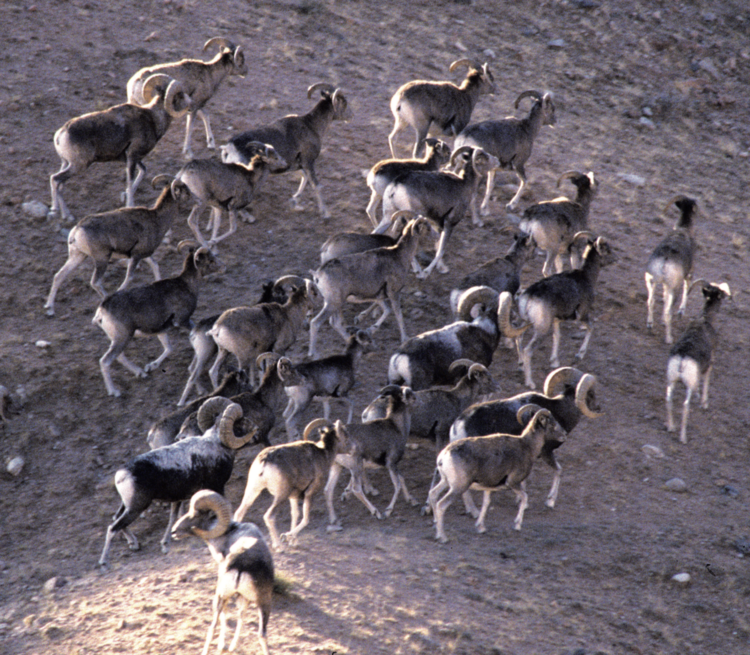
Argali del Hangai
"Ovis ammon darwini"
Taxonomically it is the same as the Gobi argali, phenotypically it has horns of size between Altai and Gobi argali. It is found especially in the Hangai mountain range.

Argali of the Gobi
"Ovis ammon darwini"
The fundamental difference with the Altai and Hangai argali is that it is smaller in body size and horns than the Altai and Hangai argali. It is found throughout the Gobi region of Mongolia, from west to east of the country and throughout the south, and in areas bordering China.
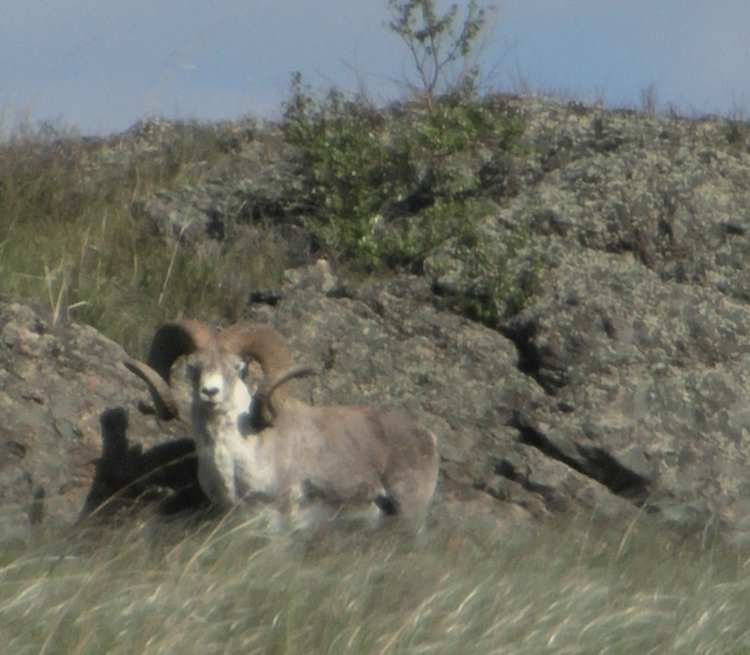
Argali of Karaganda
"Ovis ammon collium"
Dark brown in color, the body has a white collar that runs around the neck, somewhat smaller horns than the Tien San and an angular section at the base. It inhabits the central Kazakh area of Hillocky, in Kazakhstan.
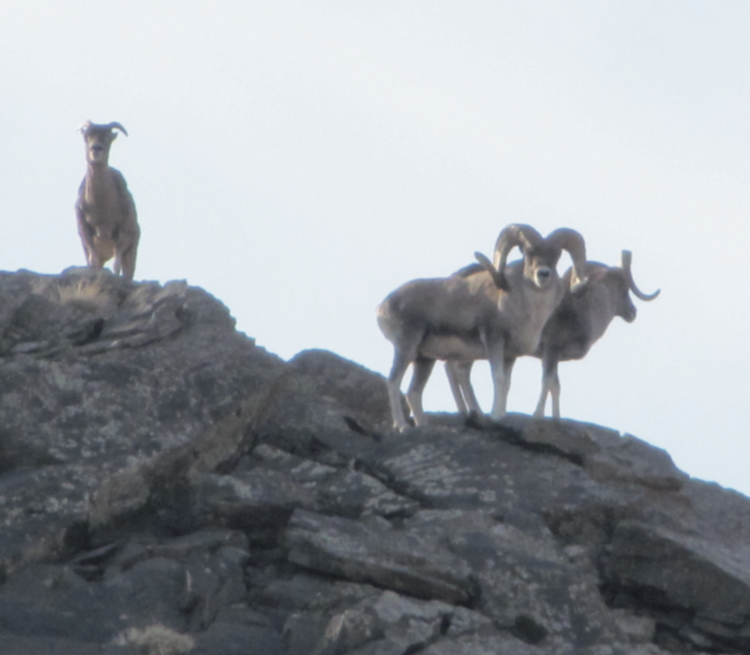
Argali of Kara Tau or nigrimontana
"Ovis ammon nigrimontana"
One of the smallest argalis. It has a characteristic whitish patch around the tail and a light brown body with a darker stripe running along the entire flank. Horns rarely exceed 90 cm. They live in the east of the Black Mountains or Kara Tau.
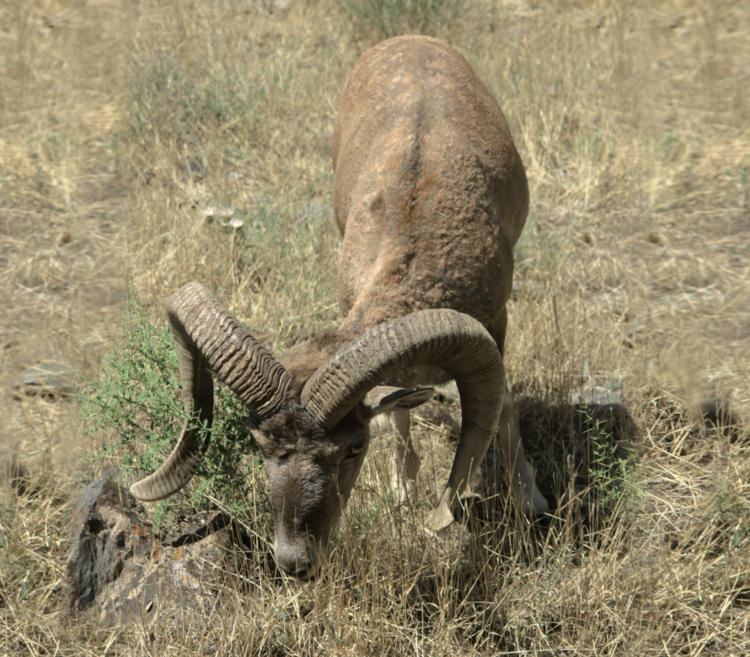
Argali of Severtozv or Nura Tau
"Ovis ammon severtozvi"
The smallest of all argalis, it is dark brown in colour, has a white belly, smaller horns than the other argalis, and has a characteristic dark necktie. It is found only in Uzbekistan, mainly in the Nura Tau Mountains.
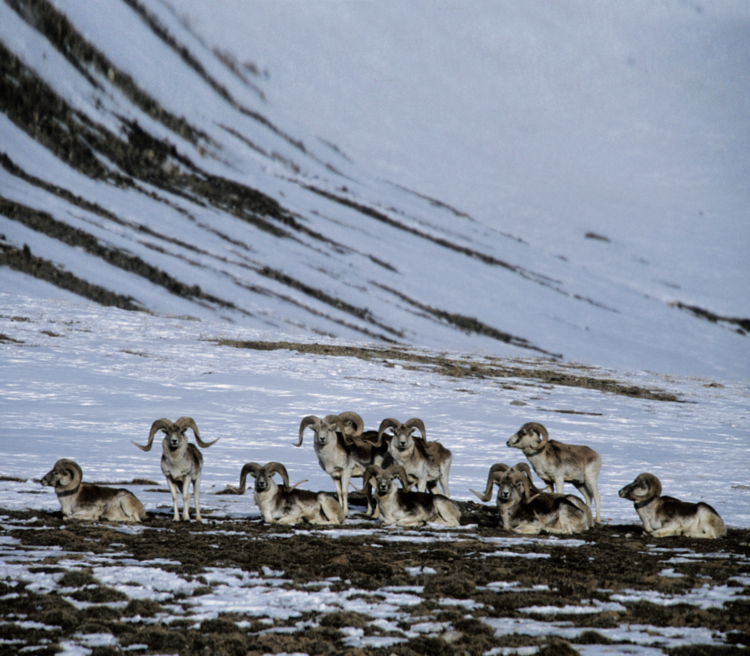
Marco Polo's Argallis
"Ovis ammon polii"
They are very varied in chestnut-coloured coats, with white legs, chest and abdomen standing out. The great length of the amber-coloured horns, triangular section and their eversion are the most characteristic features of this argali, which lives mainly in the east of the Tajik Pamir, border areas of Afghanistan, and eastern China in the Kongur mountains.
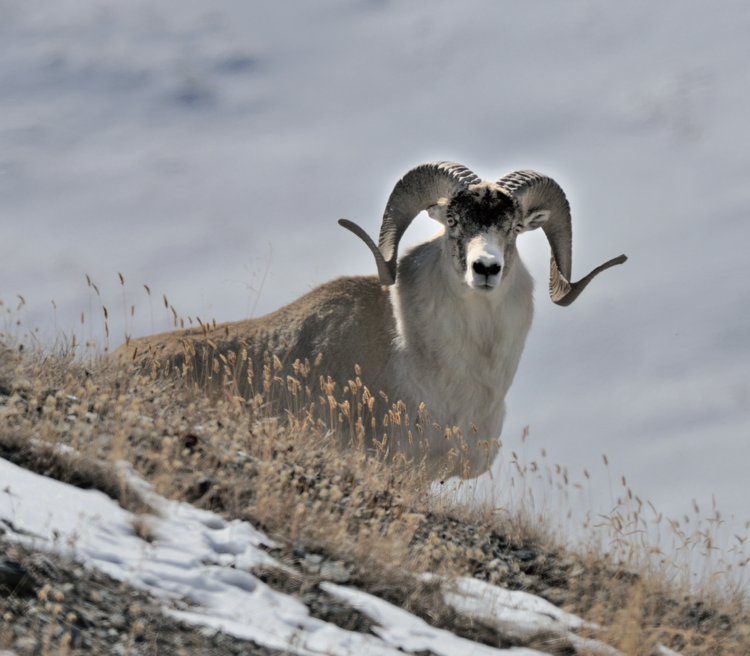
Tien San Argali
"Ovis ammon karelini"
Within this subspecies or phenotype, the Ovis a. littledalei and the Ovis a. humei are also included.
Similar in coloration to the Marco Polo argali, with shorter and thicker horns. It lives throughout the Tien San chain in Kyrgyzstan, extending eastwards into China and southwest into Kazakhstan.
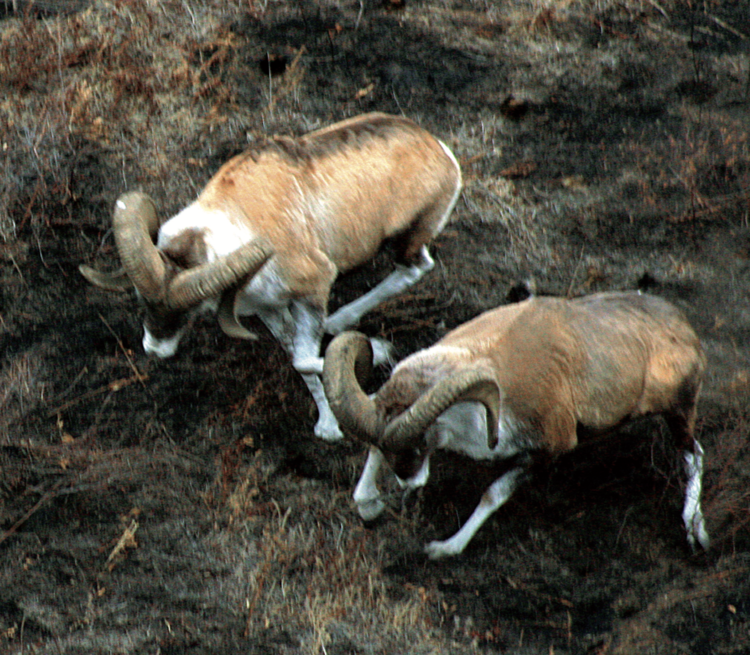
Argali of Sair
"Ovis ammon sairensis"
Similar in appearance to the Karelini, with massive horns that can complete a circle. They are found in Kazakhstan in the Tarbagatay and Sair mountains, extending into China to the east.
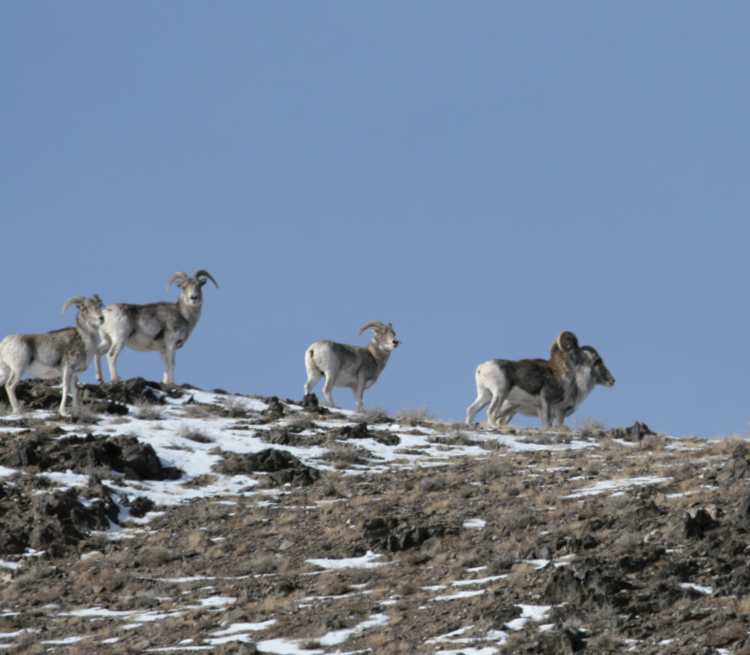
Argali from Gansu or Northern Tibet
"Ovis ammon dalai-lamae"
Chestnut to grey-brown coat, white underparts and rump, horns rounded at the front, with little evertion. Inhabits the Qinghai and Gansu regions of China.
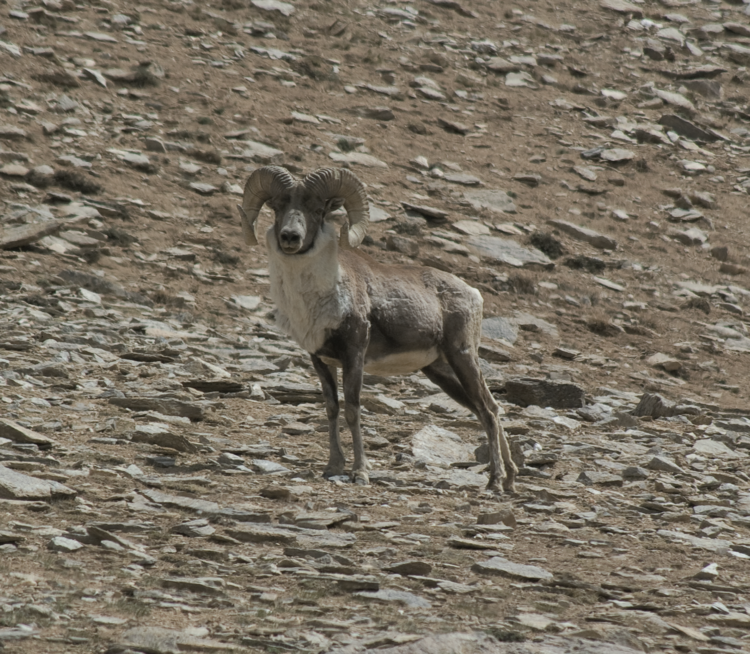
Tibetan Argali
"Ovis ammon hodgsonii"
With a chestnut and grey colouring, it stands out for its long, light-coloured mane and very small tail. It has massive horns whose tips rarely go beyond the level of its eyes. It occupies most of the Tibetan Plateau in China.
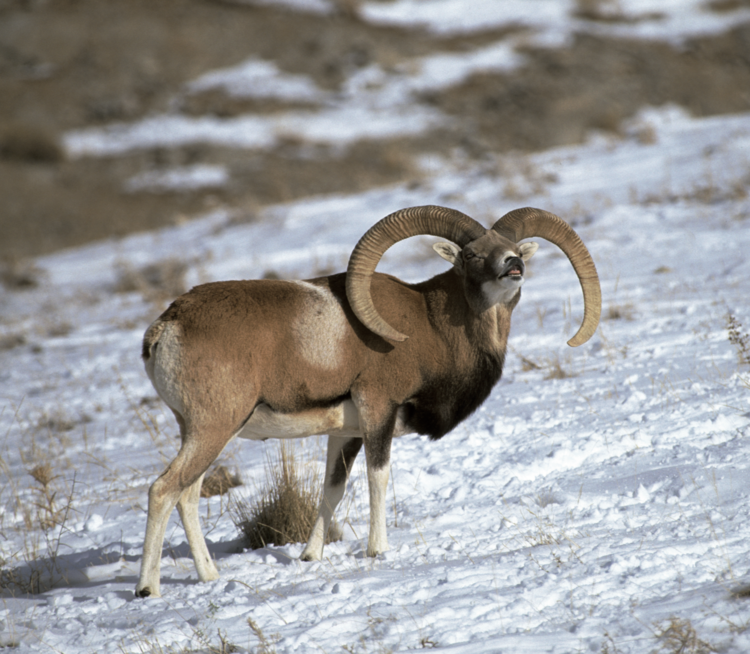
Anatolian mouflon
"Ovis gmelini anatolica"
Larger than the mouflon, in winter it has a reddish-brown coat, with a black ruff and may have a whitish saddle on the sides. Horns are normally supracervical and can exceed 75 cm in length.
Endemic to Turkey, it inhabits the central plains of Anatolia in the Konya area.
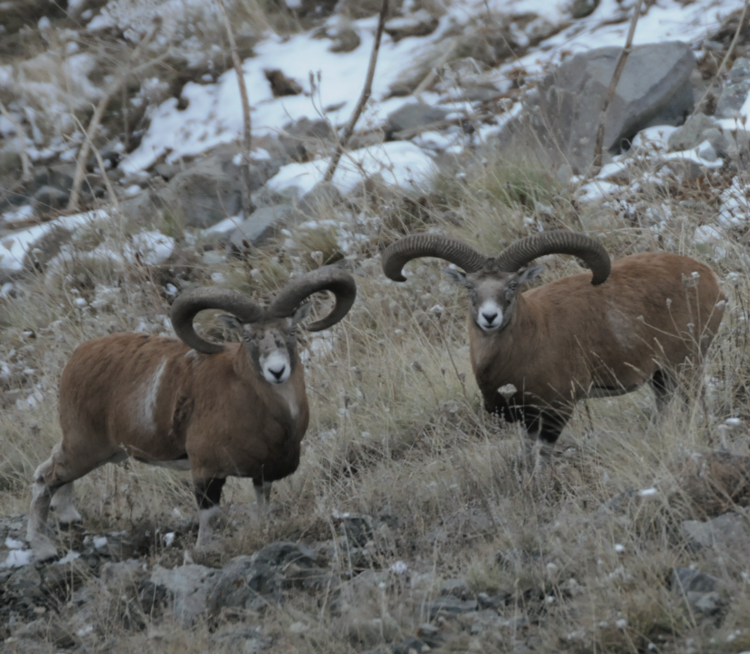
Armenian mouflon
"Ovis gmelini gmelini"
Reddish-brown fur, with a slightly marked whitish saddle on the flanks, whitish underparts and legs. Males have, especially in winter, a tie of short dark hairs. The horns are curved in a single plane and point backwards, in a supracervical position, with the tips sometimes pointing inwards or backwards. They have very marked rings.
It lives especially in the whole of western Iran, with some populations in western Azerbaijan and southern Armenia.

Isfahan mouflon
"Ovis gemelini isphahanica"
Reddish-brown fur, dark upper legs and whitish abdomen and lower legs. Inconspicuous saddle, and in males a short ruff in winter. The horns grow in a cervical position with the tips pointing towards the neck, average length 67cm.
The population is restricted to the south central part of the Isfahan region in Iran.
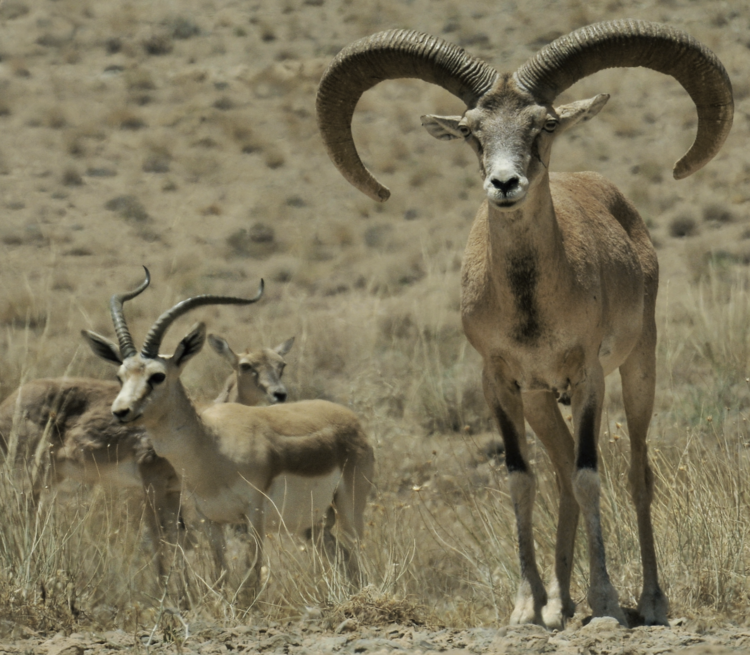
Laristan mouflon
"Ovis gemelini laristanica"
It is one of the smallest rams in the world, with a light brown coat, triangular horns that curve downwards and the tips point outwards.
Its habitat is in southern Iran, east of the city of Lar, in the provinces of Fars and Hormozgan.
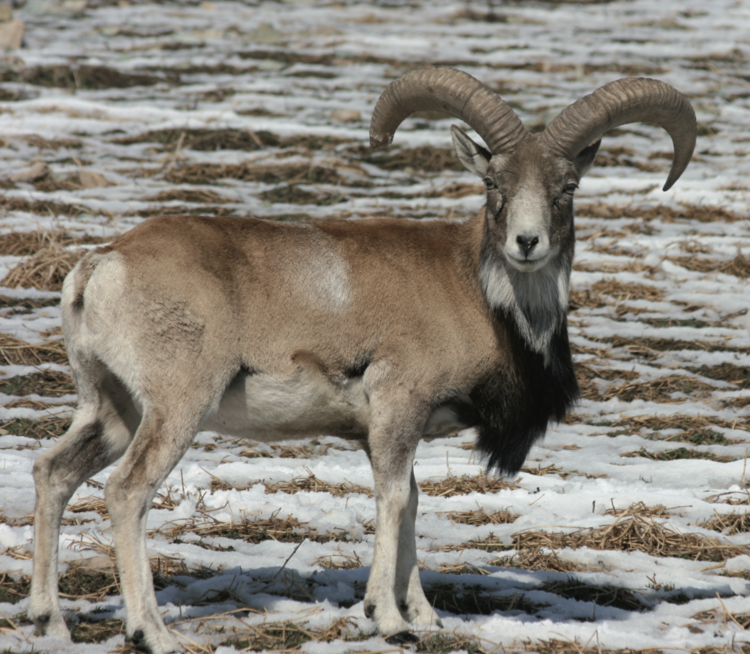
Red ram or Kavir mouflon
"Ovis o. gmelini x Ovis o. vignei"
As it is a hybrid, in the central and western Alborz they are more similar to the Armenian mouflon, while further east they are more similar to the Transcaspian urial.
It lives in the north of the province of Tehran, in the Alborz region, reaching in the south to the Kevir desert, with very diffuse limits.
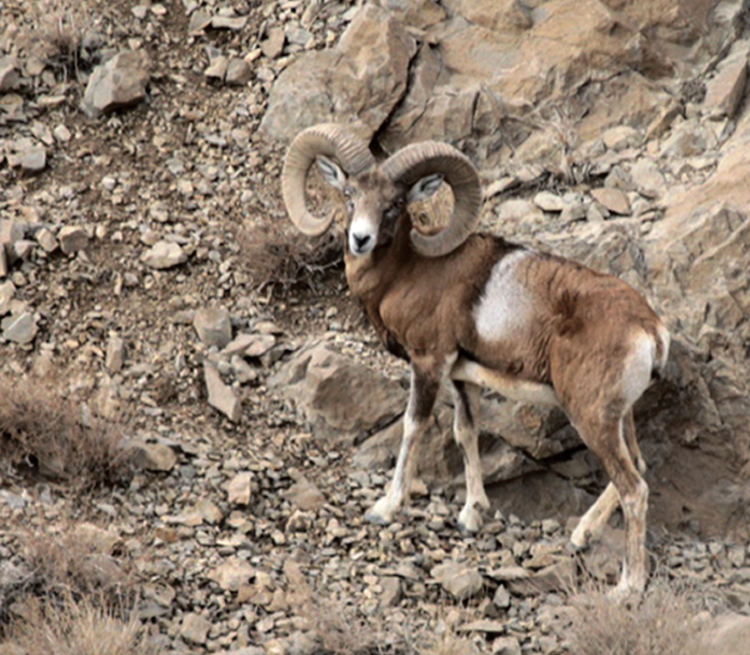
Kerman ram
"Ovis gemelini laristanica x Ovis vignei blanfordi"
Another hybrid, this time between the Laristan mouflon and the Baluchsian urial. Therefore, individuals similar to both species can be found.
The main distribution area is in the Rochun Wildlife Refuge and in the Khabr National Park.
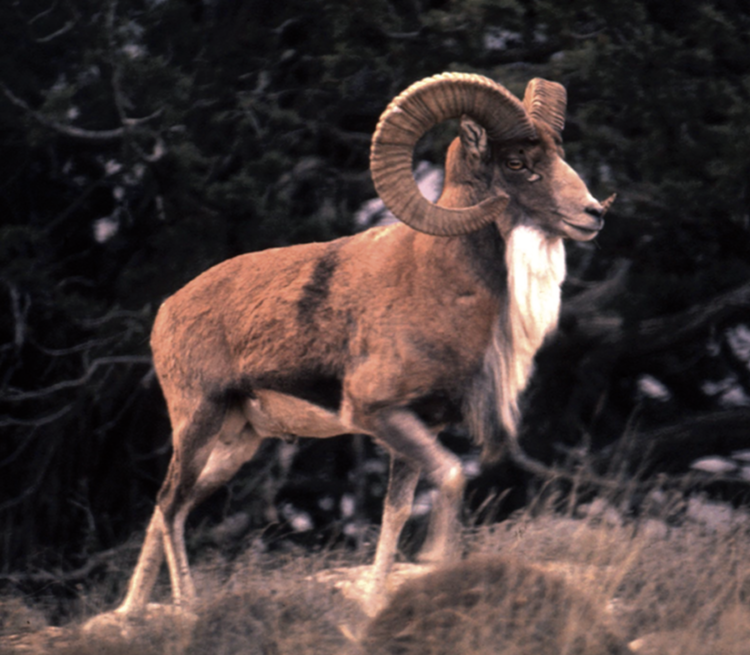
Transcaspian Urial
"Ovis vignei arkal"
It is the largest of Iran's rams, with a blond coat. Males have a long white bib that runs down the neck to the chest. Horns with marked rings slope downwards and outwards, describing a complete circumference, sometimes with the tips everted.
Its distribution area is northwestern Iran, eastwards along the border of Turkmenistan, reaching southwestern Kazakhstan and northwestern Uzbekistan.
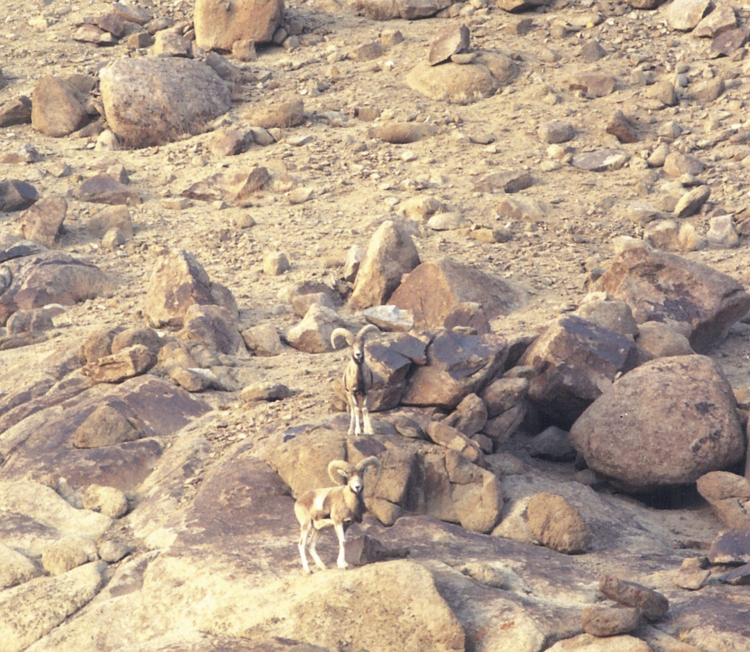
Ladakh Urial
"Ovis vignei vignei"
It is one of the largest urials, with a greyish-brown coat in winter and a coat that ranges from reddish to cinnamon the rest of the year. Supracervical horns, which protrude upwards, backwards and downwards. With the tips facing inwards in the large males, they describe almost a complete circle.
They live in northern India, Pakistan and in the Wakhan Corridor in Afghanistan and the border with Tajikistan.
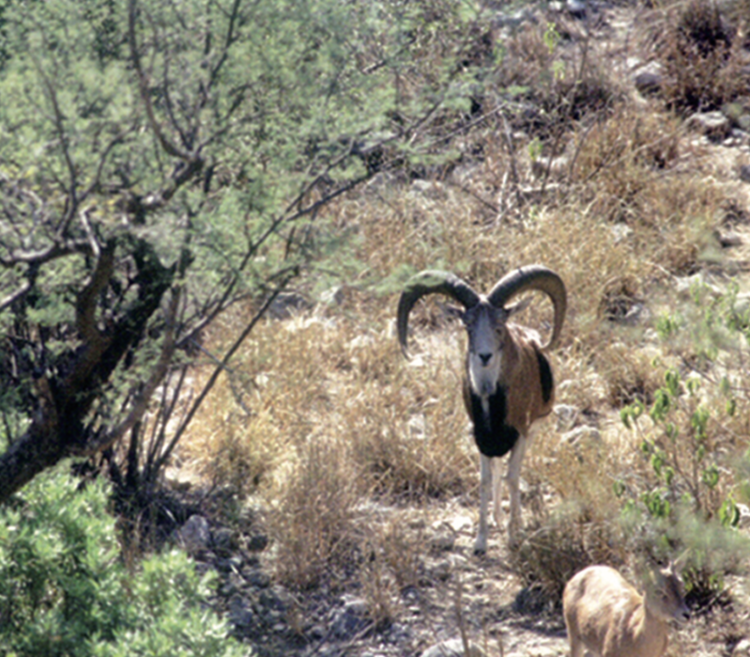
Punjab Urial
"Ovis orientalis punjabensis"
It has a dark reddish coat, with a white bib that continues with a black ruff down to the chest. The crescent-shaped horns point backwards and downwards.
It is an endemic species of Pakistan, inhabiting the province of Punjab.
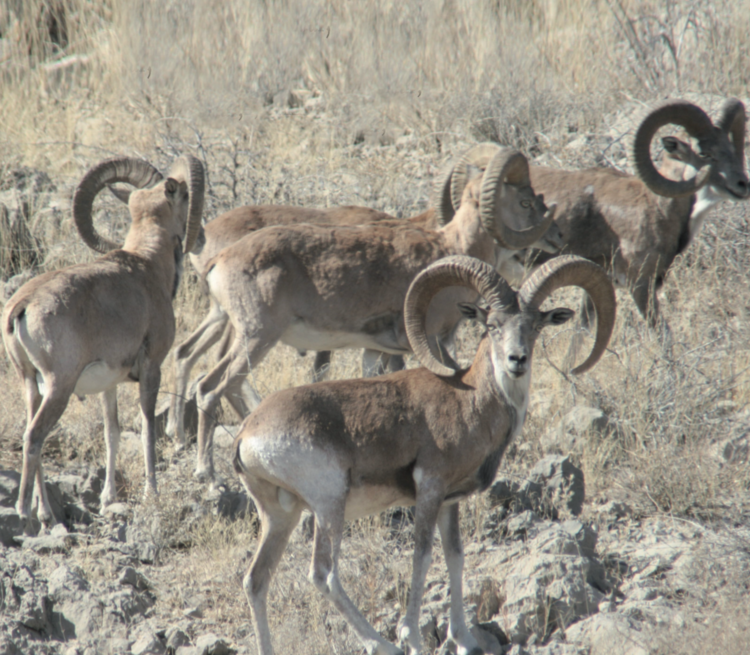
Baluchistan or Blanford's Urial
"Ovis vignei blanfordi"
The Baluchistan urial is smaller than the Transcaspian urial, with long, thin legs and cinnamon-coloured fur. Its horns are triangular in section, which curve to form an almost open circle, a typical shape of the urial.
They are found in the south-eastern region of Iran, in the province of Sistan and Baluchistan; and especially in Pakistan in the regions of Sindh and Baluchistan.
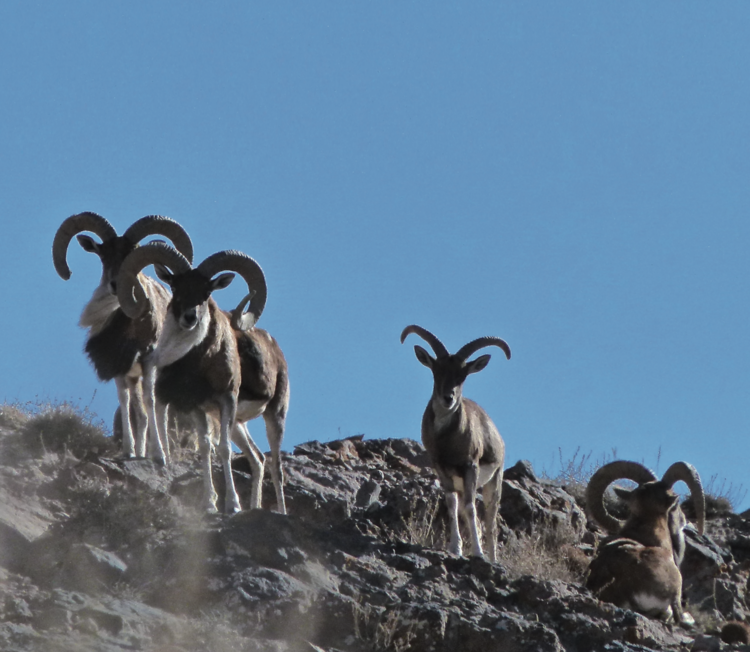
Afghan Urial
"Ovis vignei cycloceros"
It is a larger urial than the Baluchistan urial, light reddish or beige in colour, with dirty white lower parts and legs. Adult males sport a magnificent white tie followed by a black mane down to the chest. The horns, with the typical shape of the urials, almost forming a complete circle, are triangular and very ringed.
It inhabits the central area of Afghanistan from west to east, Iran in the east and even Pakistan in the east as well.
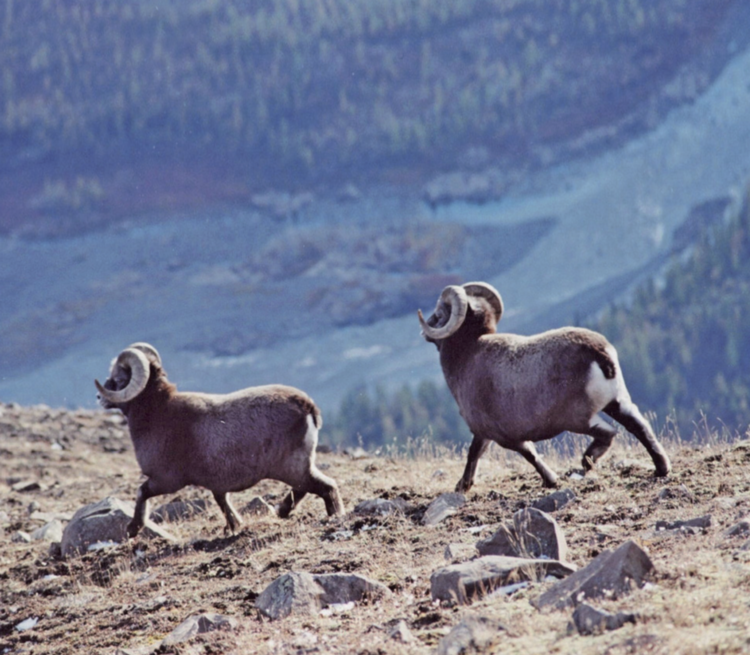
Putorana ram
"Ovis nivicola borealis"
Predominantly brownish coat, with white patch around the tail. Horns with rounded section, massive at the base and everted and thinner tips.
It lives in the Krasnoyarsk Krai, in the Russian Federation.
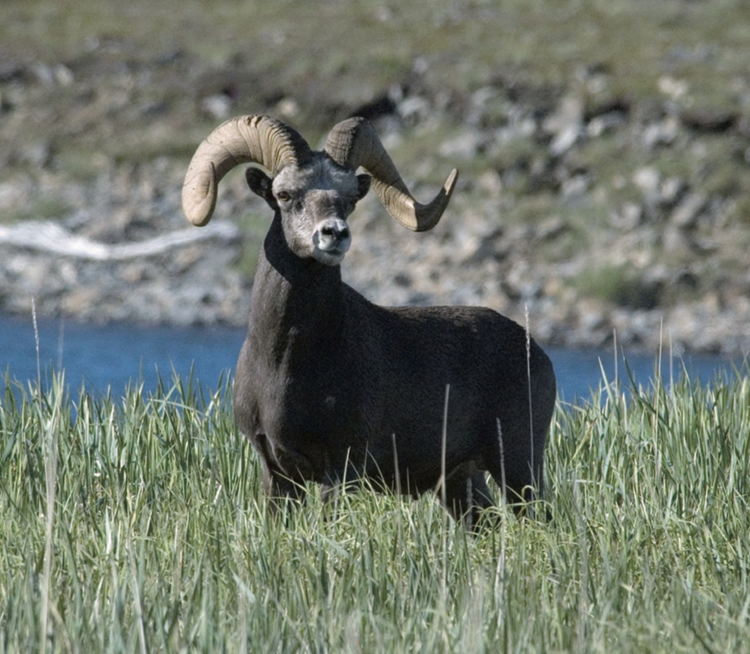
Yakut snow sheep
"Ovis nivicola lyddekeri"
The coat is lighter than that of the Kamchatka sheep, with a larger rump shield and also white. The abdomen, ears and muzzle are whitish. It may or may not have a distinctive white patch on the front.
The horns are rounded triangular in section and are less thick than those of the Kamchatka sheep. This subspecies includes the Okhotsk, Kolyma and Chukotka varieties.
It lives in the Sakha-Yakutia Republic.
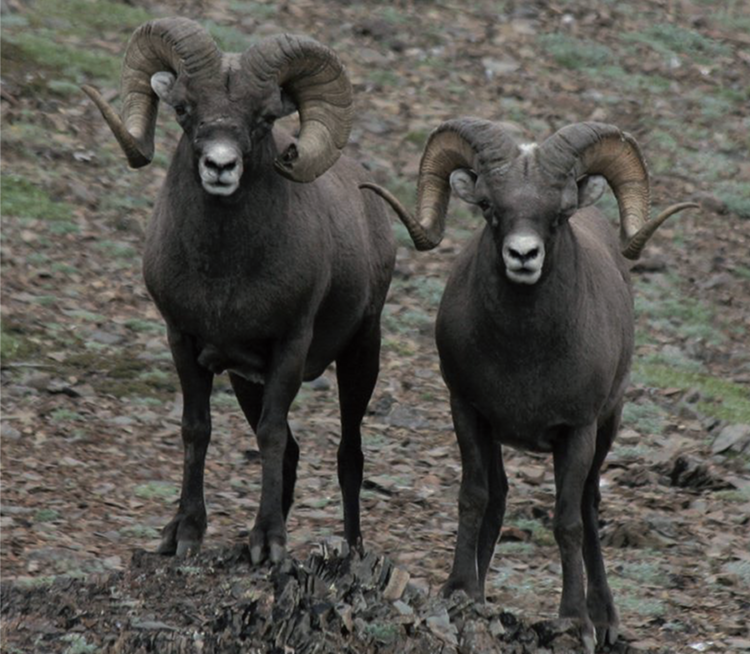
Kamchatka sheep
"Ovis nivicola nivicola"
Dark brown fur on the body and lighter on the abdomen and the extended white anal shield that occupies the entire posterior part of the rump.
The horns have the thickest bases of all snow leopards, are darker in colour and can form a complete circle. The tips protrude forward and outwards. This includes the Koryak phenotype.
It is endemic to the Kamchatka Peninsula.
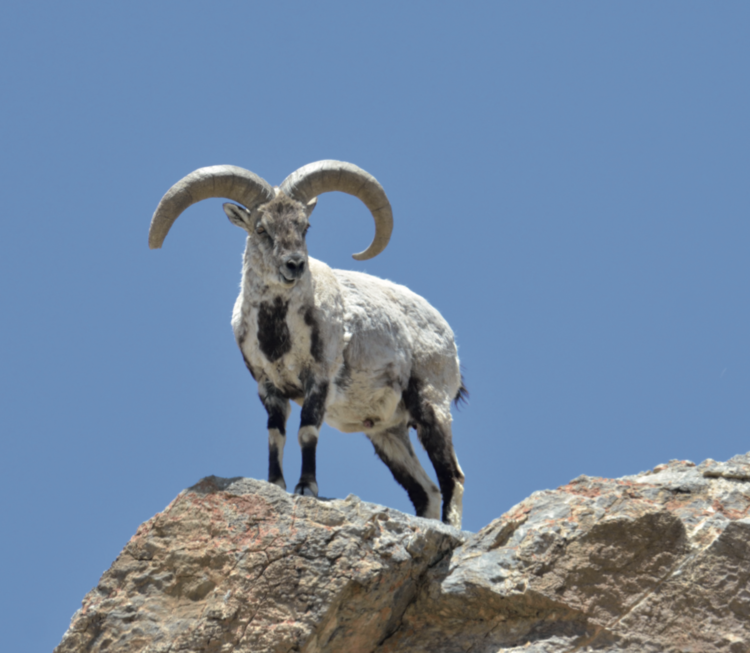
Himalayan Baral
"Pseudois nayaur nayaur"
The face has grey to black markings, and the neck and chest are also black in adult males. The front four limbs are black, interrupted by a white spot on the knees. The horns are rounded and smooth. They curve upwards, outwards, and then incline inwards, towards the neck at the height of the withers.
The distribution range is the entire Himalayan chain, in Myanmar, Bhutan, Nepal, Pakistan and on its borders with China.
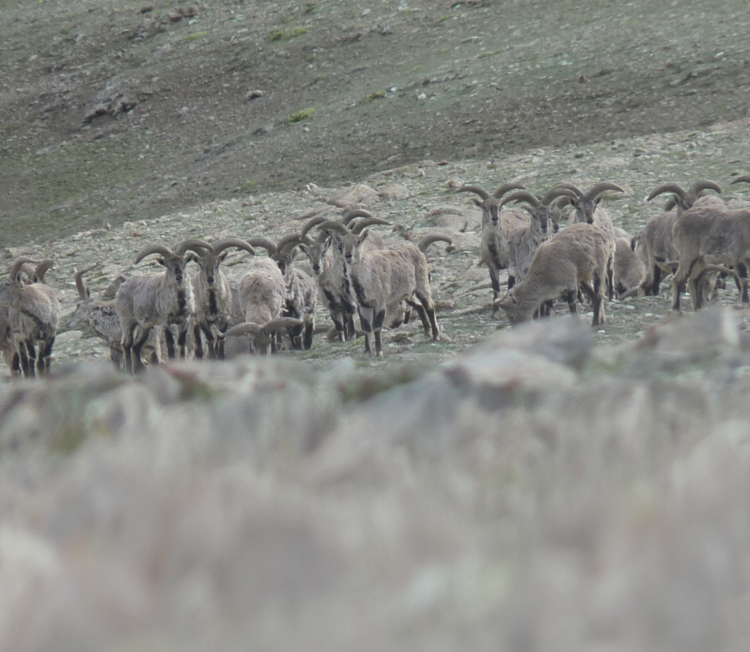
Chinese Baral
"Pseudois nayaur szechuanensis"
The Chinese Baral is smaller in body size and horns than the Himalayan. The colouring is somewhat paler than that of the Himalayan, and the difference is most noticeable in the horns, which are shorter and flatter, that is, less curved with tips that curve upwards.
They live in central China, the eastern part of the Kunlun and Altun mountains and a large part of Qinghai province.
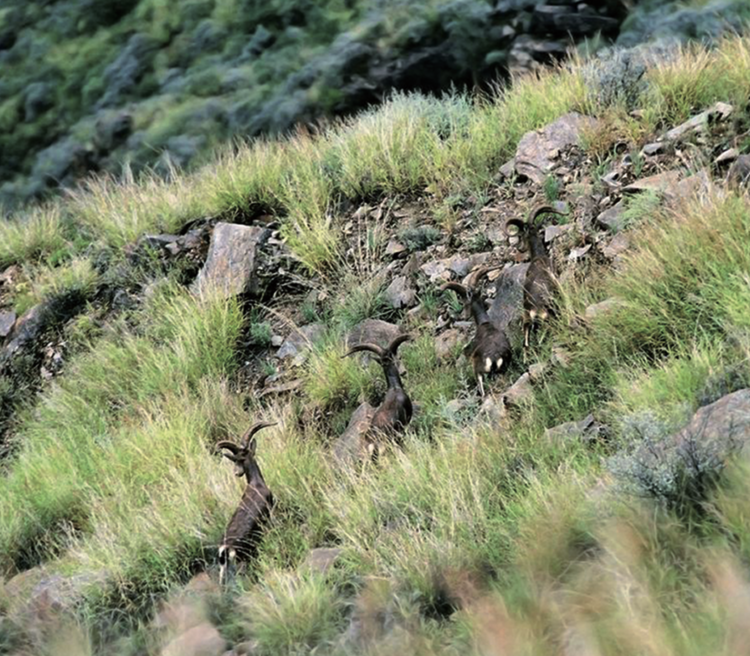
Dwarf Baral
"Pesudois schaeferi"
It is much smaller than the Himalayan baral, with a darker body colour and shorter horns, which protrude upwards but do not curve inwards. They never develop the semi-circle of the Chinese baral and the straight tips protrude upwards and outwards.
They live in China (Sichuan, Yunnan and eastern Xizang).
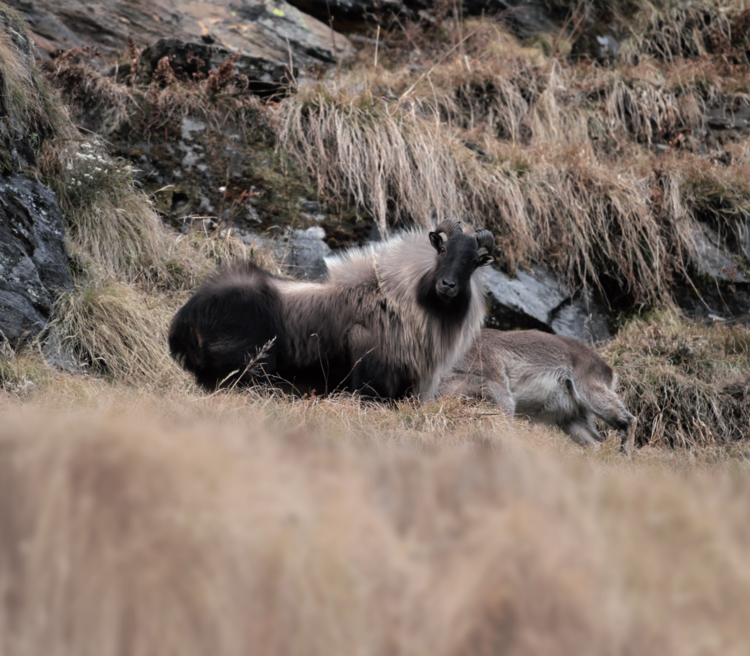
Himalayan Tar
"Hemitragus jemlahicus"
It has small horns. They are triangular in section and form a keel on the upper anterior edge where growth spurs can be seen. The characteristic of adult males, with great dimorphism with females, is the voluminous "mane" of long yellowish-brown hair.
They live in Nepal, in the Himalayan mountain range, probably in Bhutan and on the Chinese side. It has been introduced into New Zealand.
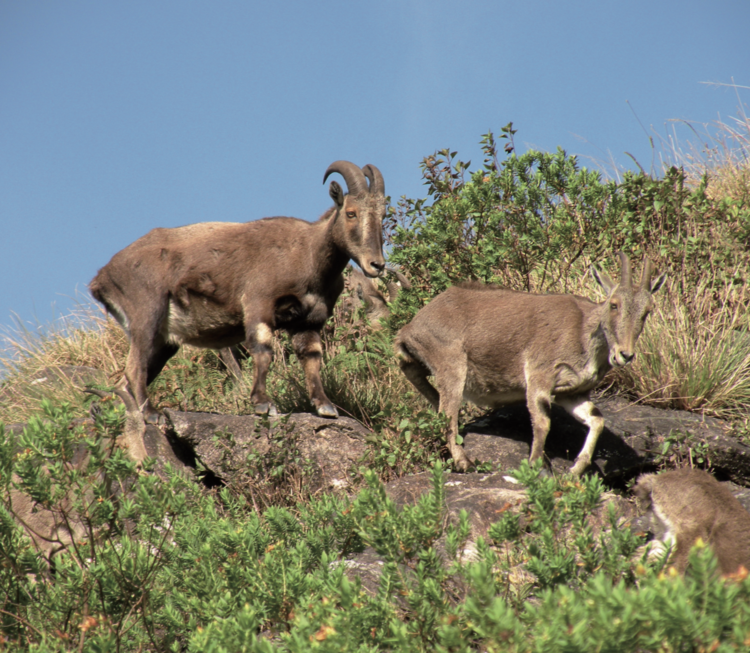
Nilgiri Tar
"Nilgiritragus hylocrius"
Adult males are dark brown to almost black in colour, with a distinctive silver saddle. Horns are curved in parallel, completely backwards and the bases almost meet, with the tips diverging. Growth rings can be seen on the first two-thirds of the horn.
Its distribution area is southern India, the Nilgiri, Palani and other hills in the area.
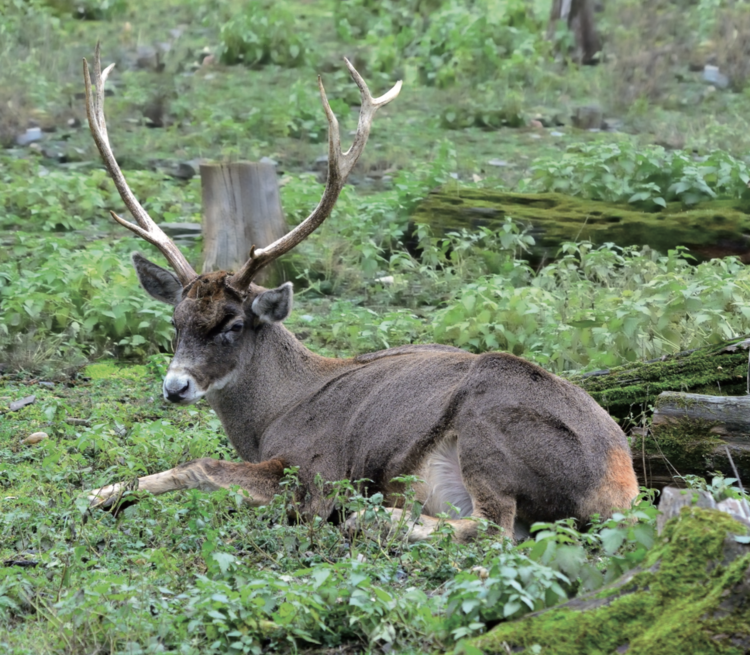
White-lipped deer
"Cervus albirostris"
A large, tall deer with a characteristic white muzzle and whitish antlers.
It lives at altitudes ranging from 3,500 to 5,100 m in the regions of Gansu, Quinghai, Sichuan and the Tibet Autonomous Region in China.
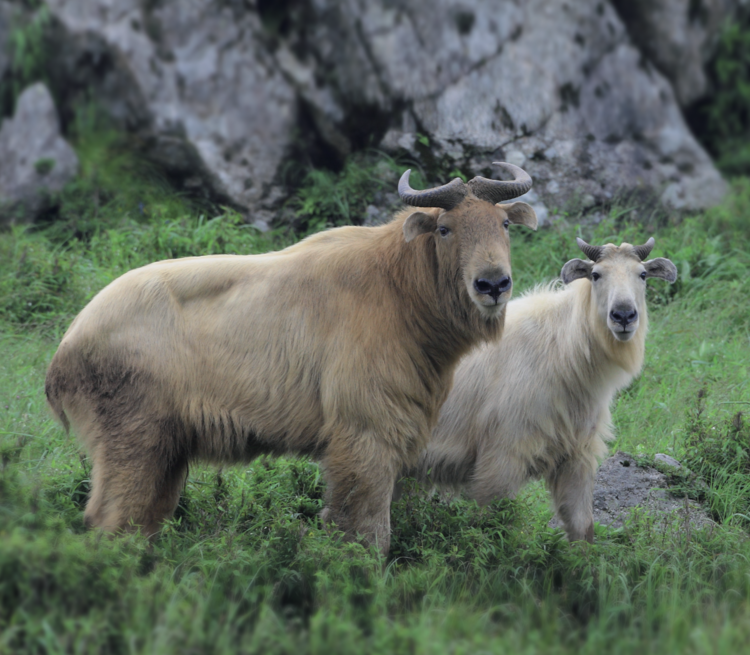
Golden Takin
"Budorcas taxicolor bedfordi"
The generic name Budorcas comes from the Greek words bous and dorcas, which mean ‘ox’ and ‘gazelle’. It has a straw-coloured to deep yellow coat, which gives it its "golden" appearance.
It lives in the Shaanxi and Gansu regions of China.

Takin from Tibet or Sichuan
"Budorcas taxicolor tibetana"
Of variable colouring, generally straw-greyish fur, with a darker dorsal stripe that reaches the withers. On the hind limbs and rump there are diffuse dark-grey spots.
It lives in the Sichuan region of China.
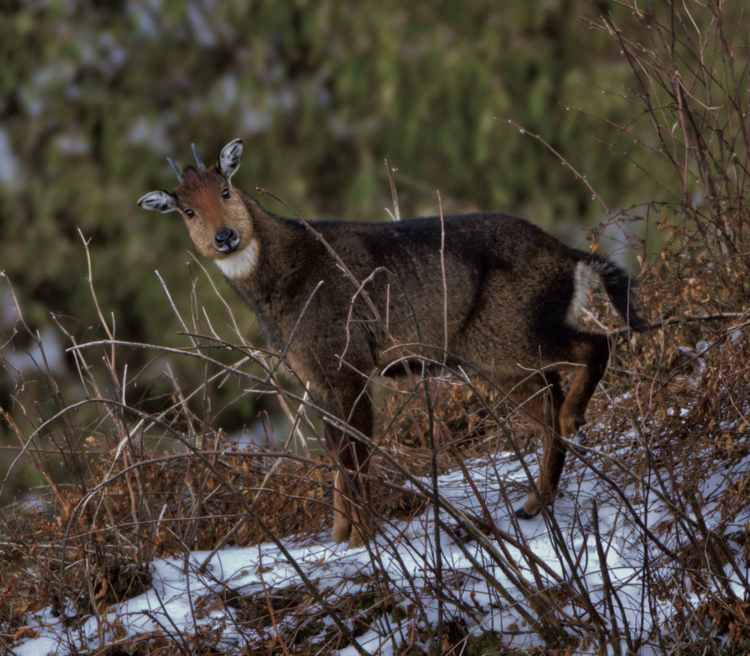
Himalayan Goral
"Naemorhedus goral"
The coloration varies depending on whether it is the eastern or western phenotype, from dark brown to straw-grey.
They have small, backward-curving, almost parallel and pointed horns, with a serrated surface.
Their distribution area covers Bhutan, Nepal, India, Pakistan and bordering areas of China.
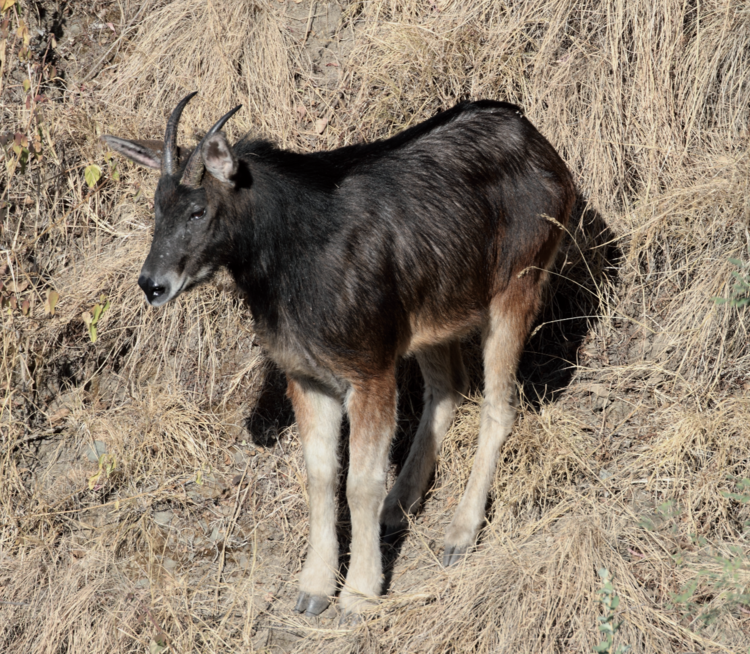
Himalayan Sirao
"Capricornis thar"
Its colour varies greatly depending on the location. It is predominantly greyish to dark, almost black, with the upper part of the front legs and haunches being reddish, and the lower parts of the limbs whitish.
The horns are not very long, conical in section and curved backwards, with a serrated surface. It lives in the foothills of the Himalayas, from India, Nepal, Bhutan and the border with China, even descending to Bangladesh.
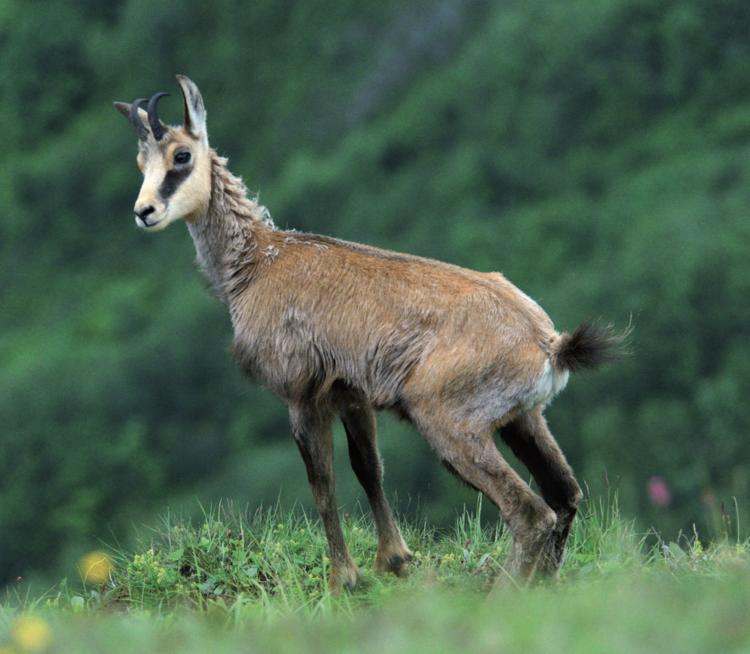
Caucasian chamois
"Rupicapra rupicapra caucasica"
It is included in both Europe and Asia, because the Caucasus region occupies both continents (North Caucasus would be Eastern Europe and South Caucasus would be the Near East).
The chamois inhabits the Russian krai of Krasnodar and Stavropol, the Caucasian republics of the Russian Federation, Georgia, South Ossetia and Azerbaijan.

Turkish or Anatolian chamois
"Rupicapra rupicapra asiatica"
The horns are thinner and shorter than those of other subspecies of chamois. In summer fur, the dorsal line, darker, can be distinguished, running along the entire back.
It is endemic to northeastern Anatolia, in Turkey, and extends somewhat into southwestern Georgia.

Middle Caucasian Tur
"Capra caucasica"
It is a hybrid between the Western or Kuban tur (Capra caucasica severtzovi) and the Eastern or Dagestan tur (Capra caucasica cylindricornis). The horns can be similar in both species or something in between in different gradients.
It inhabits the middle zone of the Caucasus, near Mount Elbrus, in the republics of Karachaevo-Cherkessia and Kabardino-Balkaria.
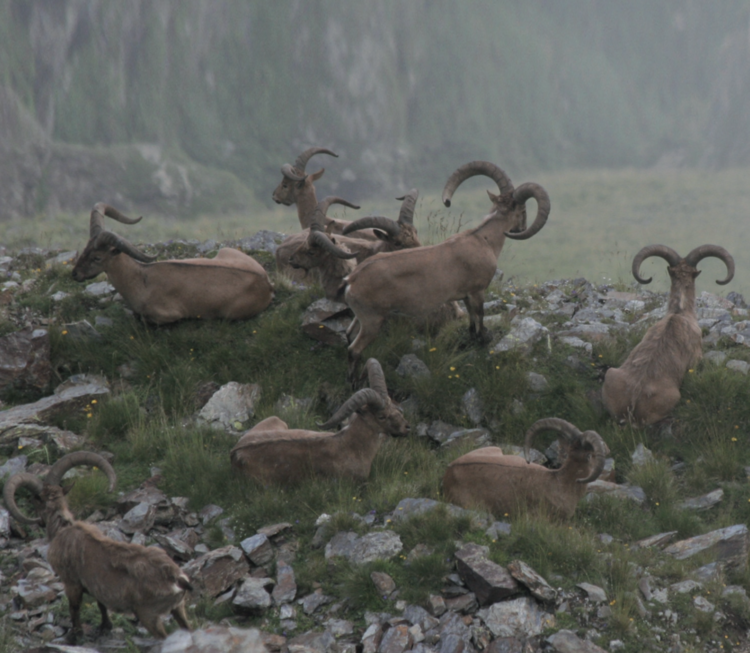
Eastern or Dagestan tour
"Capra cylindricornis"
The most distinctive feature of the morphology of the tur is the shape of its horns. The Eastern tur has horns with an almost cylindrical section, without medrones, although the annual growth lines are marked.
It lives in Azerbaijan, Georgia, and the republics of the Russian Federation of Chechnya, Dagestan, Ingushetia, Kabardino-Balkaria and North Ossetia.
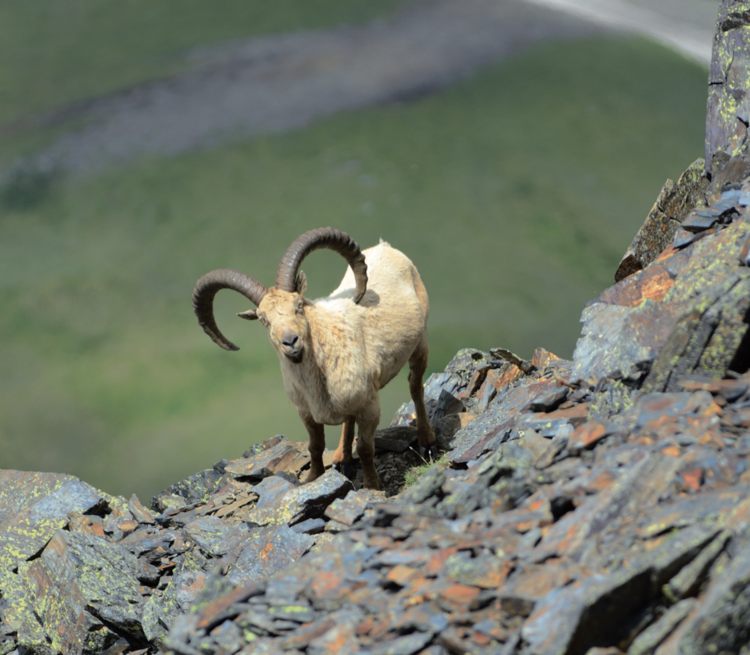
Western or Kuban tour
"Capra severtozvi"
The horns are almost quadrangular in cross section, scimitar-shaped, with pronounced horns.
It lives in the western Caucasus mountain range; in the republics of Abkhazia; and in the Russian Federation in the republics of Karachevo-Cherkessia and Adygea and the Krasnodar Krai.
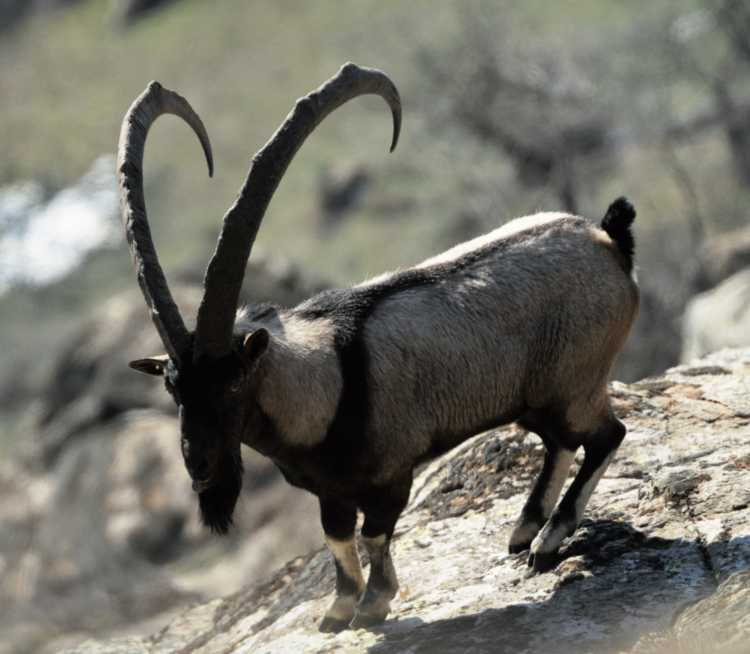
Bezoar
"Capra aegragus aegragus"
Ash to greyish brown in colour, with a dark, almost black band that runs along the entire back and, when it reaches the withers, descends in front of the shoulders, forming a collar that closes over the chest.
It has scimitar-shaped horns, with a front edge or keel, which is divided by marked medrones.
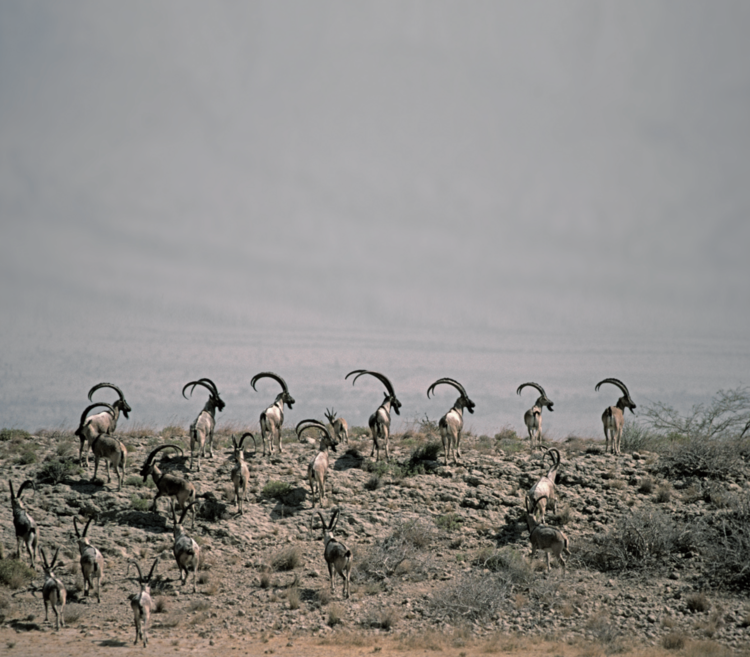
Bezoar of Sindh
"Capra aegragus blythi"
It has a whitish grey coat with an almost black dorsal band that runs down the shoulders and crosses the chest. It has long horns, with a marked keel on the front, describing an arc sometimes of almost 270 o and the tips usually divergent.
It lives in Pakistan, in the regions of Sind and Baluchistan and in Iran, in the province of Sistan-Baluchistan.
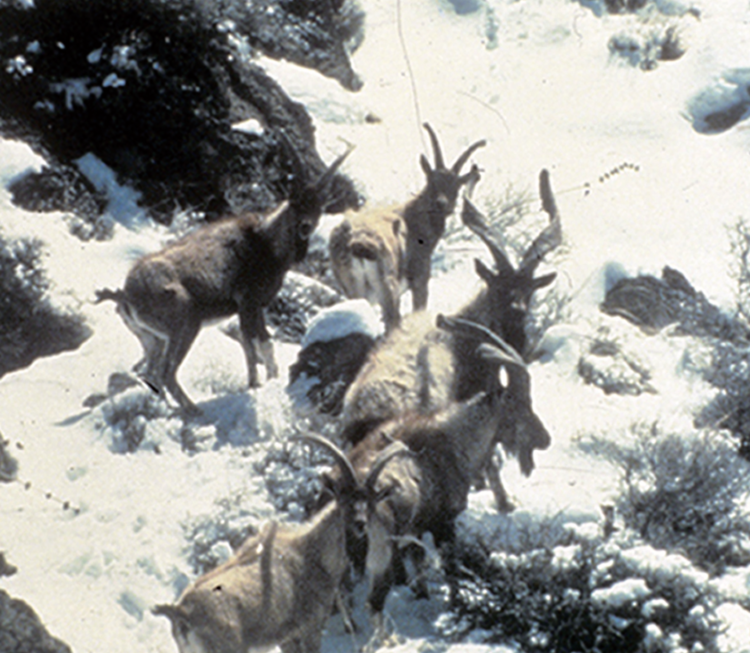
Chialtan goat
"Capra aegragus blythi x Capra falconeri megaceros."
Apparently a hybrid of a pasang and a Kabul markhor, although it has a coloration similar to that of the bezoar and the horns are a mixture of both species.

Altai Ibex
"Capra sibirica sibirica"
Scimitar-shaped horns, shorter than those of the Himalayan and Tien San ibex, with very prominent horns.
It occupies the Altai Mountains in western Mongolia, the areas bordering the border with China and Kazakhstan, and extends into the republics of Altai, Tuva, Buryatia and the provinces of Irkutsk and Krasnoyarsk in Russia.
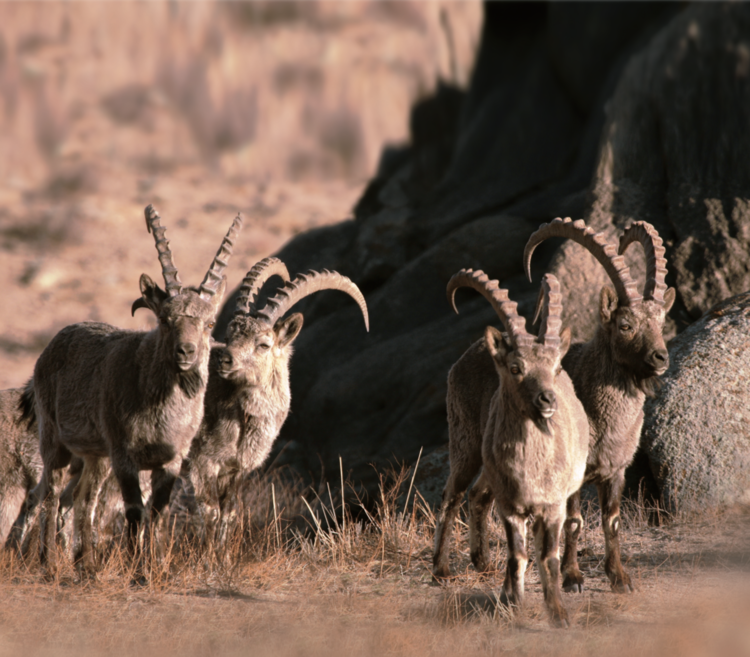
Gobi Ibex
"Capra sibirica hagenbecki"
Similar in appearance to the Altai ibex, although perhaps paler in colour. The shortest horns of all Asian ibexes.
Inhabits Mongolia in the Gobi-Altai, southern and eastern Gobi and southern Hentiy regions. In China in Gansu province and the Inner Mongolia autonomous region.
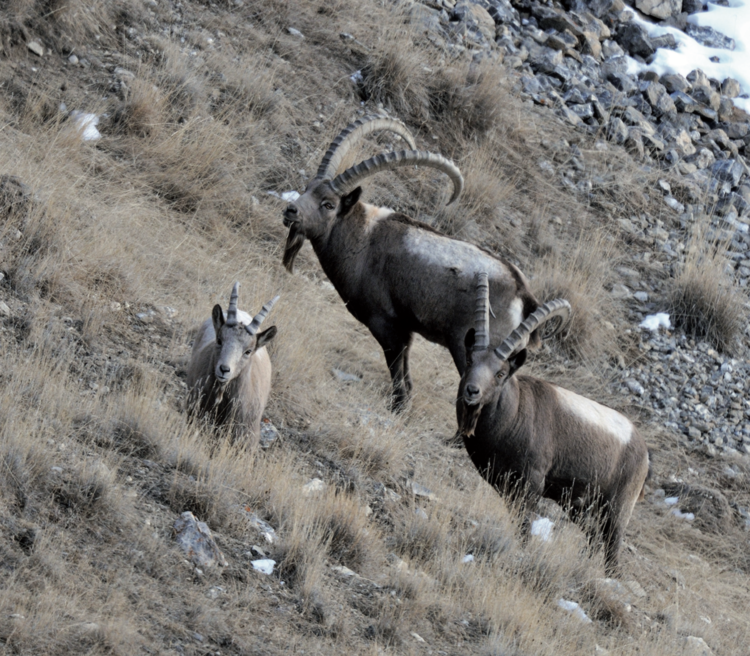
Tien San or Central Asian ibex
"Capra sibirica aliana"
It is the largest of all the Asian ibexes. It is dark in winter with a whitish dorsal saddle and dark dorsal line.
It lives in Afghanistan, Kazakhstan, Tajikistan, Kyrgyzstan and China.
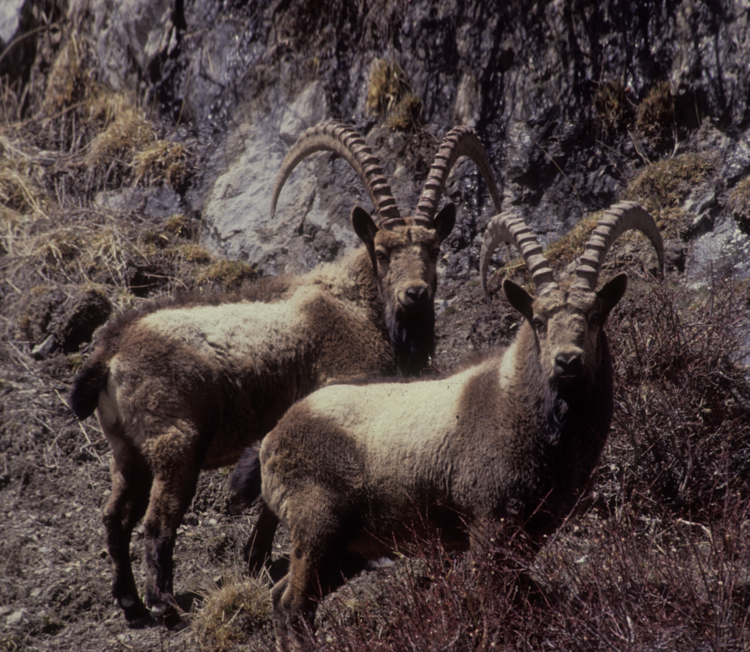
Himalayan ibex or sakin
"Capra sibirica sakeen"
Very similar in appearance and horn shape to the Tien San ibex, although somewhat smaller.
Its range extends from the Afghan Karakoram and the Wakhan Corridor in Afghanistan to Pakistan, where it inhabits several northern regions, and India, in the Karakoram and Himalayan regions as well.
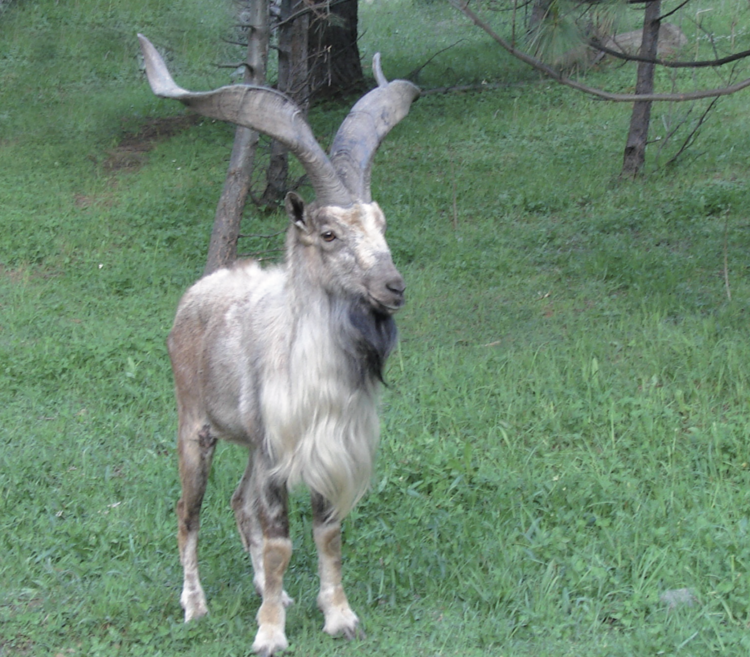
Marjor of Astor
"Capra falconeri falconeri"
It is the markhor with the most divergent and spectacular horns of all the markhors.
The Astor markhor is a phenotype endemic to the province of Gilgit-Baltistan, in the foothills of Nanga Parbat, in northern Pakistan.
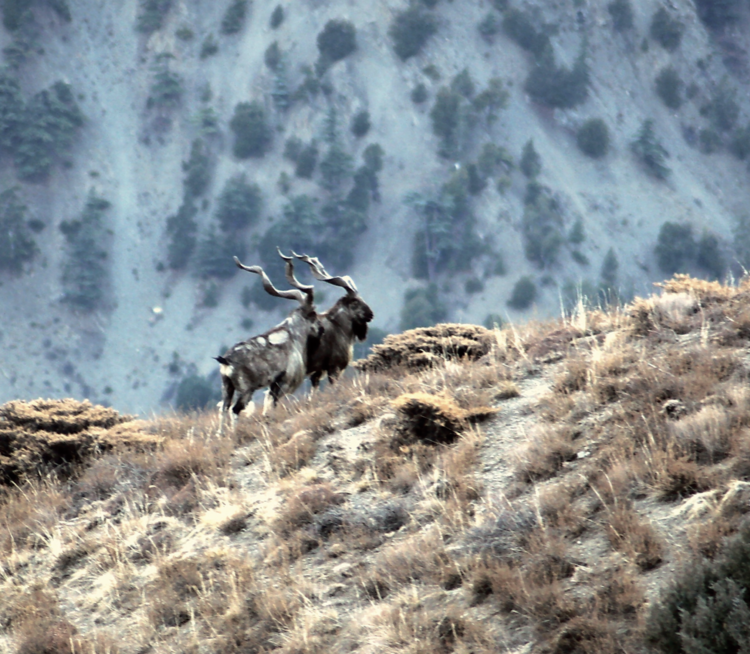
Marjor of Kashmir
"Capra falconeri cashmiriensis"
The horns are less divergent than those of the Astor, with two or three turns in the spiral.
It lives in northern Pakistan in the Chitral region and westwards in Afghanistan and in the Pir Panjal area in India.
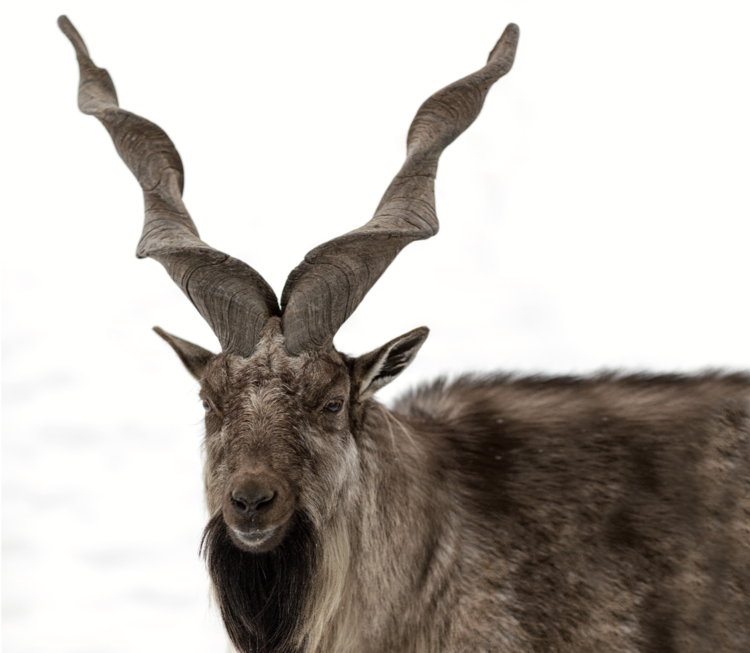
Markor from Kabul
"Capra falconeri megaceros"
It is a smaller phenotype of markhor than the previous ones. It has straighter horns, almost joined at the base and with a spiral that makes two, three and sometimes even four complete turns.
Its distribution range is near Kabul, in Afghanistan, and in Pakistan in the areas bordering the border in northern Baluchistan.

Marjor of Suleiman
"Capra falconeri jerdoni"
It is the smallest of all the markhors, and its horns are also shorter than those of the Astor and the Kashmir. They form a tighter spiral with several complete turns and are usually in the shape of an inverted triangle.
It lives in Pakistan, Baluchistan, and in Afghanistan, areas of Paktika and Zabol.
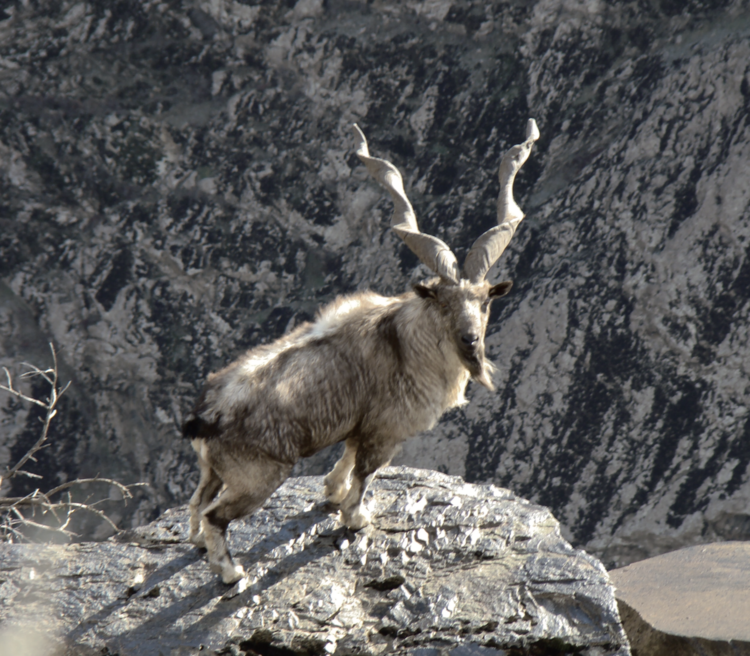
Marjor of Bukhara
"Capra falconeri heptneri"
Intermediate in size between the Suleiman and the larger markhors. The horns develop in a massive spiral, more open than that of the Suleiman, with the tips usually worn down.
It lives in Afghanistan, in the Badakhshan region, in Tajikistan, Turkmenistan and Uzbekistan.
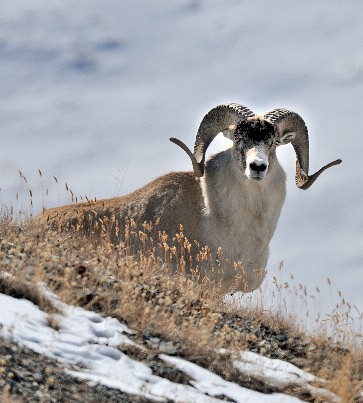
Hume's Argali
"Ovis ammon humei"
Males are large in size, with robust and curved horns that can reach impressive lengths, making them a distinctive feature.
The coat varies between light brown and gray tones, with a white belly and a dark line along the back.
It is primarily found in the mountains of Central Asia, including regions of Tajikistan, Kyrgyzstan, and parts of Afghanistan.
It inhabits rocky terrains and high-altitude grasslands, generally at elevations above 3,000 meters.
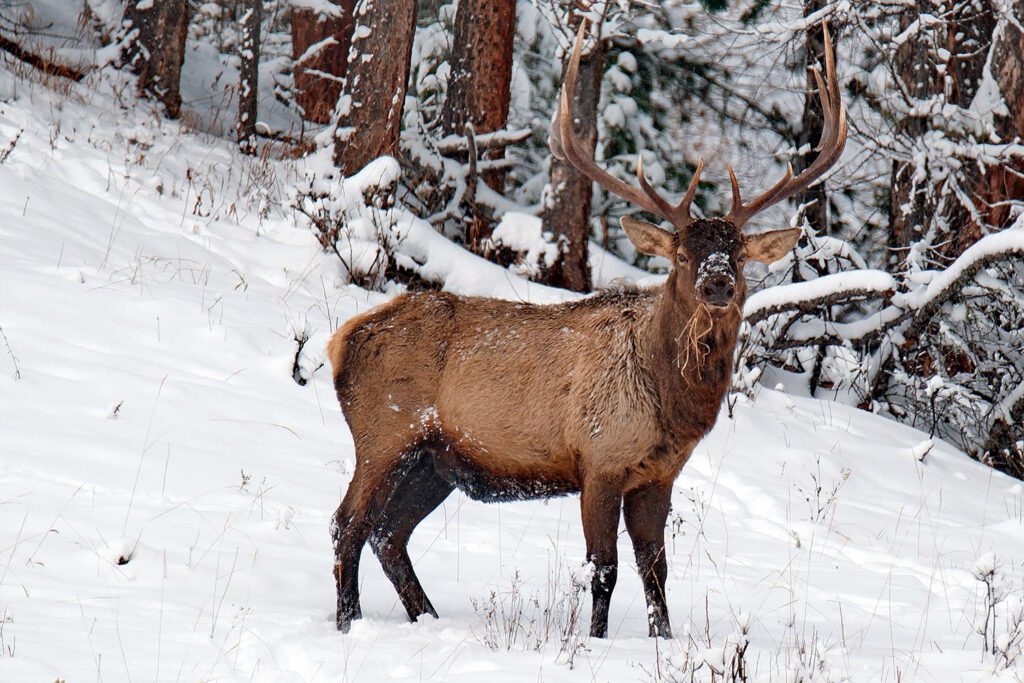
Tien Shan´s Maral
"Cervus elaphus songaricus"
Males are large, with robust bodies weighing between 250 and 300 kg.
Their antlers are impressive, featuring multiple branches that can exceed 1.2 meters in length.
The coat is dense, dark brown in winter and lighter in summer, with a pale underside and rear.
Prefers coniferous forests, alpine meadows, and mountain valleys. It is commonly seen at elevations between 1,500 and 3,500 meters.
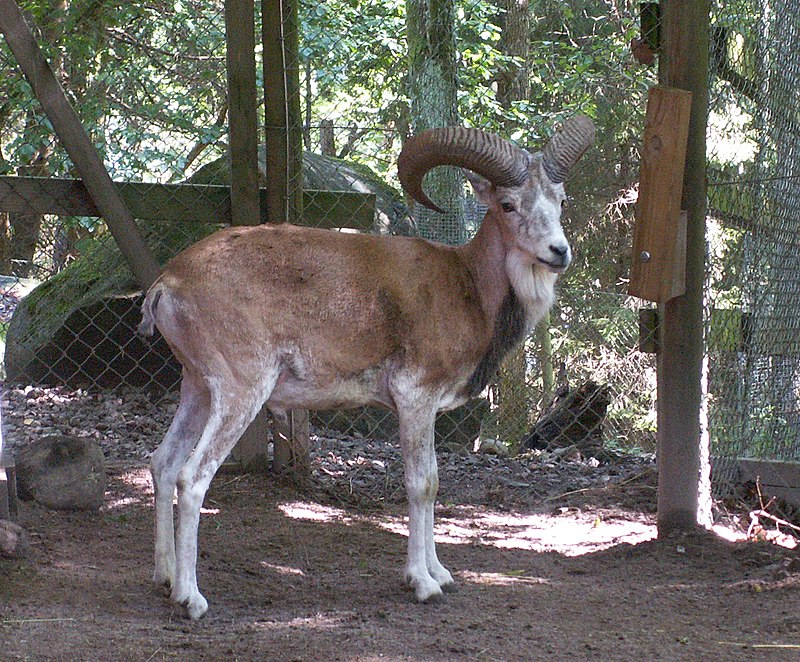
Bukhara Urial
"Ovis vignei bocharensis"
Is a subspecies of urial (Ovis vignei), a wild sheep native to the mountainous and desert regions of Central Asia, particularly around Bukhara in Uzbekistan and adjacent areas of Turkmenistan and Tajikistan. It is well adapted to arid climates and rugged terrains.
Males feature large, backward-curving horns that can reach impressive lengths.
Their coat is short and reddish-brown in summer, turning more grayish in winter. Males have a black mane on their neck and chest.